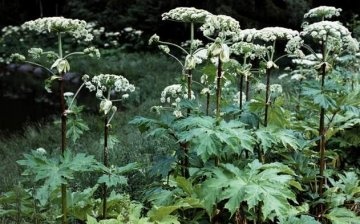Hogweed plant - danger or benefit
Very often along the roadsides along the road you can find huge mutant plants, the inflorescences of which look like umbrellas with white flowers, and the growth of plants reaches about 4 meters. The hogweed plant is widely known as poisonous, because many stories are connected with how the yard boys fighting this "enemy" received burns and poisoning.
The hogweed plant is indeed quite poisonous, but not all of its species. The poisonous substance in this plant is essential oils and coumarins, which are especially dangerous during the flowering period of hogweed. Their activity also depends on the type of plant, for example, Sosnovsky's hogweed is very often used for feed to livestock in the form of silage. In the old days, young shoots and leaves of hogweed were used as a seasoning during the preparation of various dishes, salads were prepared from them, and also simply dried, but before that, the leaves of the plant were soaked well to get rid of toxic substances.
Siberian hogweed is quite often used in folk medicine, but it is necessary to use decoctions from this plant after observing a strict recipe and clear recommendations for that from the attending physician.
The hogweed plant belongs to long-term and high-yielding crops. It multiplies quite quickly, especially on black soil, so it is most often referred to as a weed that is difficult to get rid of. During the Soviet era, the plant was grown for production purposes, but after improper care, it grew very quickly and today represents a real threat to fields and forests.




Whatever useful properties the cow parsnip may have, at present it is a natural disaster for our fields, which are in a state of disrepair and it will hardly be easy to clean them of the cow parsnip, it is too tenacious.
I do not associate hogweed with benefit in any way, in my opinion it is a natural disaster created by a human hand. Even the sight of this powerful weed is frightening and leads to the futility of fighting it.